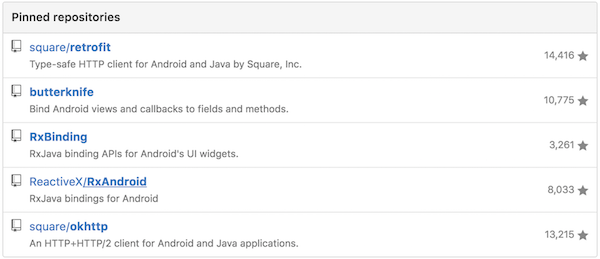Retrofit 源码分析
最近非常流行 Retrofit+RxJava+OkHttp 这一整套的网络请求和异步操作的开源框架,从 Jake Wharton 的 Github 主页也能看出其趋势。

本文主要介绍 Retrofit 的基本原理,基于 2.1.0 版本的源码。
1. 基本用法
1.1 定义 API 接口
Retrofit 的使用非常简单,先来看一个 官网 上的示例代码。
|
|
官方的解释是
Retrofit turns your HTTP API into a Java interface.
首先定义了一个 API 接口 GitHubService,包含 HTTP 请求的方法 GET 和参数 user,及成功后的返回类型 List<Repo>,方法和参数由注解声明,非常清晰。
1.2 创建 Retrofit 对象并生成 API 实例
|
|
然后创建一个 Retrofit 对象,这里采用 Builder 模式,传入 baseUrl 和 ConverterFactory 等参数,后面会讲到。
通过 Retrofit 对象用动态代理的方式生成我们需要的 API 实例 GitHubService。
1.3 API 实例去请求服务
|
|
用生成的 API 实例调用相应的方法,默认返回 Call<T>,然后调用 Call#execute 方法同步或调用 Call#enqueue 方法异步请求 HTTP。
|
|
请求返回的数据直接转化成了 List<Repo>,非常方便。
如果要使用 RxJava,在创建 Retrofit 对象时要调用 addCallAdapterFactory(RxJavaCallAdapterFactory.create()),则返回类型会从 Call<T> 转换成 Observable<T>。
2. Retrofit
2.1 build
先看一下 Retrofit.Builder 类里的成员变量。
|
|
Platform 提供了3个平台:Java8,Android 和 IOS,全都继承自 Platform,初始化时静态方法 Platform#findPlatform 会自动识别属于哪一个。
|
|
通过 Retrofit.Builder#client 或 Retrofit.Builder#callFactory 可以自定义 OkHttpClient。
|
|
如果不指定 callFactory,则默认使用 OkHttpClient。
|
|
converterFactories 和 adapterFactories 提供了2个工厂列表,用于用户自定义数据转换和类型转换,后面会详细说明。
最后调用 Retrofit.Builder#build 创建一个 Retrofit 对象。
|
|
2.2 create
|
|
首先调用 Utils.validateServiceInterface 去判断 service 是否是一个 Interface 且没有继承其他 Interface,否则抛非法参数异常。
|
|
如果 validateEagerly 为 true,则会调用 eagerlyValidateMethods 方法,会去预加载 service 中的所有方法,默认为 false。
|
|
然后就是通过动态代理生成 service。前两个 if 分支分别判断是否是 Object 的方法及 default 方法,后者除了 Java8 其他都是 false。
再看 loadServiceMethod
|
|
通过 serviceMethodCache 实现缓存机制,同一个 service 的同一个方法只会创建一次,生成 ServiceMethod 同时存入 Cache。
用 ServiceMethod 和需要的参数生成一个 OkHttpCall 对象。然后用 CallAdapter 将生成的 OkHttpCall 转换为我们需要的返回类型,这个后面会说到。
3. ServiceMethod
Adapts an invocation of an interface method into an HTTP call.
ServiceMethod 的作用就是把一个 API 方法转换为一个 HTTP 调用。
从 Retrofit#loadServiceMethod 方法中可以看出一个 API 方法对应一个 ServiceMethod。
以 GitHubService为例
|
|
@GET("users/{user}/repos") 是 MethodAnnotations,@Path("user") String user 是 ParameterAnnotations,Call<List<Repo>> 是 CallAdapter。
3.1 ServiceMethod.Builder
先看下 ServiceMethod.Builder 的构造函数
|
|
传入 retrofit 和 method 对象,通过 method 获取到方法注解 methodAnnotations、参数类型 parameterTypes 和参数注解 parameterAnnotationsArray,parameterAnnotationsArray是一个二维数组 Annotation[][],因为一个参数可以有多个注解。
关键看 ServiceMethod.Builder#build 方法,会生成一个 ServiceMethod 对象,接下来按顺序解析。
3.2 createCallAdapter
callAdapter = createCallAdapter() 会遍历 adapterFactories,通过 API 方法的 annotations 和 returnType 取到第一个符合条件的 CallAdapter。
|
|
然后取到 responseType = callAdapter.responseType() 并进行判断,如果是 retrofit2.Response<T> 或 okhttp3.Response 则抛异常,目前支持的有默认的 retrofit2.Call<T>,RxJava 的 rx.Observable,Java8 的 java.util.concurrent.CompletableFuture 和 Guava 的 com.google.common.util.concurrent.ListenableFuture。
3.3 createResponseConverter
responseConverter = createResponseConverter() 会遍历 converterFactories,通过 API 方法的 annotations 和 responseType 取到第一个符合条件的 Converter<ResponseBody, T>。
|
|
3.4 parseMethodAnnotation
|
|
遍历 API 方法的所有 annotations,如实例中的 @GET("users/{user}/repos"),根据所属类型和值解析成 HTTP 请求需要的数据。
在 package retrofit2.http 下包含了所有的 Method Annotation 和 Parameter Anootation。
DELETE、GET、HEAD、PATHC、POST、PUT、OPTIONS、HTTP 类型的 annotaion 会调用 parseHttpMethodAndPath,生成 httpMethod、hasBody、relativeUrl、relativeUrlParamNames。
retrofit2.http.Headers 类型的 annotaion 会调用 parseHeaders,生成 headers。
Multipart 和 FormUrlEncoded 类型的 annotaion 分别生成 isMultipart 和 isFormEncoded,两者互斥,不能同时为 true,否则会抛异常。
然后对生成的部分参数检查,httpMethod 不能为空,如果 hasBody 为 false,则 isMultipart 和 isFormEncoded 必须也为 false,否则会抛异常。
|
|
3.5 parseParameterAnnotation
|
|
遍历每个参数的 parameterAnnotations,如实例中的 @Path("user") String user,根据所属类型和值解析成对应的 ParameterHandler,每个 Parameter Anootation 类型都有对应的 ParameterHandler,且每个参数只能有一个 ParameterHandler。
可以看下 parseParameter 的逻辑
|
|
关键在 parseParameterAnnotation,根据 annotation 的类型并做参数校验,会生成不同的 ParameterHandler,如 RelativeUrl
|
|
由于 Retrofit 不依赖 Android SDK,判断 type 时无法获取到 android.net.Uri.class,因此采用了 "android.net.Uri".equals(((Class<?>) type).getName()) 的技巧。
每个 Parameter Anootation 都会对应一个 ParameterHandler,如 static final class Path<T> extends ParameterHandler<T>,它们都实现了 ParameterHandler<T>。
| ParameterAnnotation | ? extends ParameterHandler |
|---|---|
| Url | RelativeUrl |
| Path | Path |
| Query | Query |
| QueryMap | QueryMap |
| Header | Header |
| HeaderMap | HeaderMap |
| Field | Field |
| FieldMap | FieldMap |
| Part | Part |
| PartMap | PartMap |
| Body | Body |
每种 ParameterHandler 都通过 Converter<F, T> 将我们的传参类型转化成 RequestBuilder 需要的类型,并设置其参数。举个例子
|
|
valueConverter.convert 将我们的传参类型 T 转换成 String,并设置到 RequestBuilder 中。其他的配置也是按同样的方式。
4. OkHttpCall
OkHttpCall 实现了 retrofit2.Call<T>,看下它的构造函数,传入 ServiceMethod 和请求参数。
|
|
4.1 createRawCall
先看下 OkHttpCall#createRawCall
|
|
将已经生成的 serviceMethod 通过 toRequest(args) 转成一个 okhttp3.Request 对象。再用创建 Retrofit 时指定的 okhttp3.Call.Factory 创建一个 okhttp3.Call,这里如果不指定 okhttp3.Call.Factory,则默认是 okhttp3.OkHttpClient。
在 ServiceMethod#toRequest 方法中,用 method 相关的配置生成一个 retrofit2.RequestBuilder 后,再用之前准备好的 parameterHandlers 处理每一个参数,最后生成一个 okhttp3.Request。
|
|
4.2 execute
okhttp3.Call#execute 用于同步请求 HTTP,线程会被阻塞,请求成功后返回我们指定的数据类型。
|
|
首先检查 okhttp3.Call 是否已被执行。
一个 okhttp3.Call 只能被执行一次,可以调用 OkHttpCall#clone 重新创建一个新的相同配置的 HTTP 请求。
|
|
然后检查并创建 okhttp3.Call,调用 okhttp3.Call#execute 执行同步请求。
最后调用 parsePesponse 将返回的 okhttp3.Response 解析成我们需要的数据。
|
|
对 okhttp3.Response 进行一些状态码检查后调用 ServiceMethod#toResponse 生成我们需要的数据类型。这里就用到了我们之前准备好的 responseConverter。最后封装成一个 retrofit2.Response<T>,包含了原始的 rawResponse、我们需要的 body 和 errorBody,我们取需要的数据。
4.3 enqueue
okhttp3.Call#enqueue 和 okhttp3.Call#execute 流程类似,异步请求 HTTP,然后将回调都交给 retrofit2.Callback<T> 处理。
看下 retrofit2.Callback#onFailure 的注释
Invoked when a network exception occurred talking to the server or when an unexpected exception occurred creating the request or processing the response.
这里 retrofit2.Callback#onFailure 除了处理网络异常外,还会处理创建网络请求和解析数据的异常,在回调中处理,而不是直接 crash,这点做的非常好。
createRawCall抛出的异常12345try {call = rawCall = createRawCall();} catch (Throwable t) {failure = creationFailure = t;}如果出异常,直接回调,不执行接下来
enqueue方法。- 执行
okhttp3.Call#enqueue时okhttp3.Callback抛出的网络请求异常 网络请求成功后在
okhttp3.Callback#onResponse中parseResponse时抛出的异常123456try {response = parseResponse(rawResponse);} catch (Throwable e) {callFailure(e);return;}
5. CallAdapter
前面已经简单介绍过 ServiceMethod#createCallAdapter,它会从 adapterFactories 中找到第一个符合条件的 CallAdapter.Factory。
5.1 retrofit-adapters
先来看 Retrofit 提供的 retrofit-adapters 模块,目前供我们选择使用的有 guava、java8 和 rxjava,分别对应的 CallAdapter.Factory 是 GuavaCallAdapterFactory、Java8CallAdapterFactory 和 RxJavaCallAdapterFactory。
在 Retrofit#build 时,除了我们自己添加的 CallAdapter.Factory, 还会添加两个默认的 CallAdapter.Factory:ExecutorCallAdapterFactory 和 DefaultCallAdapterFactory。
|
|
在 Retrofit 源码中有大量类似 List<CallAdapter.Factory> adapterFactories = new ArrayList<>(this.adapterFactories); 的例子,不直接使用成员变量,而是将成员变量重新拷贝给一个新的临时变量,这样虽然多申请了4个字节内存,但如果以后将成员变量改成入参,就可以不用改代码直接使用了,是一种好的编码习惯。
5.2 default
再看默认的 CallAdapter.Factory
|
|
DefaultCallAdapterFactory 和 ExecutorCallAdapterFactory 返回的类型都是 retrofit2.Call<R>。
在 DefaultCallAdapterFactory 中,CallAdapter#adapt 什么都不做,直接返回 retrofit2.Call<R>。而 ExecutorCallAdapterFactory 的 CallAdapter#adapt 则返回 ExecutorCallbackCall<T>,它实现了 retrofit2.Call<R>,会传入一个 Executor,同步调用不变,异步调用时会在指定的 Executor 上执行。
5.3 adapt
看下 CallAdapter 的 adapt 方法
|
|
它的作用就是把 retrofit2.Call<R> 转换成我们需要的 T。
| CallAdapters | ? extends CallAdapter.Factory | T |
|---|---|---|
| guava | retrofit2.adapter.guava.GuavaCallAdapterFactory | com.google.common.util.concurrent.ListenableFuture |
| java8 | retrofit2.adapter.java8.Java8CallAdapterFactory | java.util.concurrent.CompletableFuture |
| rxjava | retrofit2.adapter.rxjava.RxJavaCallAdapterFactory | rx.Observable |
| default | retrofit2.ExecutorCallAdapterFactory | retrofit2.Call |
| default | retrofit2.DefaultCallAdapterFactory | retrofit2.Call |
List<CallAdapter.Factory> 中添加的顺序是我们指定的一个或多个 CallAdapter.Factory,默认的 ExecutorCallAdapterFactory 和 DefaultCallAdapterFactory,查找时按顺序查找。
6. Converter
Converter 的作用就是将 HTTP 请求返回的数据格式转换成我们需要的对象,或将我们提供的对象转换成 HTTP 请求需要的数据格式。
|
|
接口非常清晰,将 F 转换成 T。
6.1 Factory
来看 Converter.Factory
|
|
responseBodyConverter用于将 HTTP 请求返回的 response 转换成我们指定的类型。requestBodyConverter用于将Body、Part、PartMap3种类型的参数转换成 HTTP 的请求体。stringConverter用于将Field、FieldMap、Header、Path、Query、QueryMap这几种类型的参数转换成String。
6.2 retrofit-converters
和 CallAdapter 类似,Retrofit 也提供了默认的 Converter.Factory——BuiltInConverters,只能处理基本的 ResponseBody、RequestBody 和 String 类型。
在 Retrofit 提供的 retrofit-converters 模块,供我们选择的有 Gson、Jackson、Moshi、Protocol Buffers、XML、Scalar 和 Wire,我们常用的有 GsonConverterFactory。
需要注意的是,Jake Wharton 在他的一篇演讲 Simple HTTP with Retrofit 2 中说道
I want to stress that the order matters. This is the order in which we’re going to ask each one whether or not it can handle a type. What I have written above is actually wrong. If we ever specify a proto, it’s going to be encoded as JSON, which will try and deserialize the response buddy as JSON. That’s obviously not what we want. We will have to flip these because we want to check protocol buffers first, and then JSON through GSON.
说的就是 Retrofit.Builder#addConverterFactory 的顺序非常重要,先添加的 Converter.Factory 会先用来解析,而 Gson 非常强大,如果第一个添加 GsonConverterFactory,则其他想要转换的类型如 Protocol Buffers 就不会执行,因此建议将 GsonConverterFactory 作为最后一个添加。
7. 总结
Retrofit 的源码还是很难的,反反复复看了很多遍,除了其原理和流程外,从中也学到了一些技巧和设计模式。在写这篇文章的同时又把思路和流程重新理了一遍,对自己帮助还是非常大的。关于源码最大的感受就是各个类之间传对象调用感觉非常乱,也增加了理解的难度,如 Retrofit 和 ServiceMethod 之间就互相依赖。
本文是 慌不要慌 原创,发表于 https://danke77.github.io/,请阅读原文支持原创 https://danke77.github.io/2016/08/06/retrofit-source-analysis/,版权归作者所有,转载请注明出处。
如果觉得我的文章对您有用,请随意打赏。您的支持将鼓励我继续创作!
